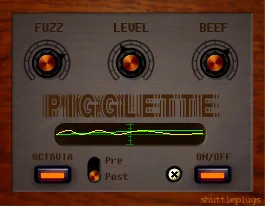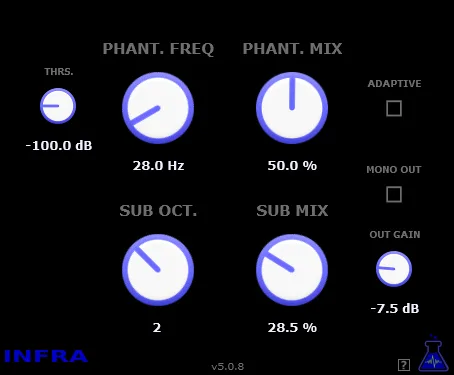Piglette: Your New Favorite… Horror?
Discover Piglette by Shuttleplug – a plugin that deliberately breaks all the rules and gives your tracks a sound you never even suspected. It’s not just an effect, it’s a character. Rude, unpredictable, sometimes frankly nasty, but it is in its “nastiness” that the spark that can make your sound truly unique is hidden. It is the “best version” of this deliberately “horrible” effect.
Piglette is an emulation of a fuzz circuit created with a single goal: to be as “incorrect” as possible. Forget about smooth, perfect distortions. This beast is for those moments when you need a sound that cuts the ear (in a good way!), breaks the structure, and adds unexpected aggression. The developers spent a lot of time perfecting this “incorrectness,” and it seems they succeeded. This is a plugin for experimenters, for those who are not afraid to go beyond the limits and are looking for their own, unique sound palette. Finding the right place for Piglette in your mix is a real art, but when you find it, the result can be stunning.
Despite its extreme nature, Piglette is able to surprise. You can also work with it more delicately. Even such a “disgusting” effect can become a subtle tool for tonal shaping. With the FUZZ control fully turned left and the Octavia turned off, you can use the BEEF and BIAS knobs for interesting tonal modeling, adding subtle saturation or changing the density of the sound. This makes Piglette not just a single-function effect, but a tool with hidden depth, which is able to completely destroy your signal (in a creative sense) and add a barely noticeable, but important shade to it. It can work as an amplifier, as an enhancer, giving the sound new textures and overtones, even if you do not seek complete destruction. This allows you to use it not only for creating strong, aggressive sounds, but also for adding character and “fat” or, conversely, “thinness” where it is needed.
Key Piglette controls:
- FUZZ: This is the heart of the plugin. The amount of fuzz distortion. The higher the value, the dirtier and richer the sound becomes. This is the very knob that makes Piglette “nasty” in the most charming way. It determines the degree of clipping and harmonic saturation, creating the characteristic “fuzzy” sound of fuzzes.
- BEEF: Increases the overall signal gain in a wide frequency range. This control adds “meat” and density to your sound, making it more substantial and present, even before it is passed through the fuzz circuit. This can be useful for both shaping the input signal and overall saturation, giving the sound a deeper foundation.
- SCOPE: A visualizer that shows how Piglette (yellow line) affects the input signal (green line). This is a useful tool for understanding exactly how the waveform changes under the influence of settings, helping you to visually assess the degree of distortion and compression that occurs inside the plugin, and to better understand how each control affects the signal.
- OCTAVIA: This switch activates the octave effect, which straightens the signal, creating distorted upper harmonics an octave higher than the fundamental tone. This adds a synthesizer or metallic character to the sound, making it even more extreme and futuristic. The effect is especially interesting when working with guitars or basses, but can create unique textures when processing other instruments.
- PRE/POST: A switch that determines the position of the Octavia effect – before (PRE) or after (POST) the main fuzz engine. The location of the octave has a significant impact on the final sound. If it is before the fuzz, the fuzz will process a signal already saturated with harmonics. If after – the octaver will add harmonics to the already distorted signal. Experiment with this switch to find the most interesting combinations and understand how the order of effects changes the overall character of the sound.
- BIAS: A small white screw to the left of the On/Off switch. This is the bias control of the circuit. Reducing it makes the effect more subtle, “skeletal,” removing some of the low frequencies and changing the distortion character, making it more “hungry” or “stripped.” Increasing it, on the other hand, can make the sound fuller and richer, sometimes adding compression and “fat.” This control is key to fine-tuning the “flavor” of the fuzz, allowing it to fit into the mix or, conversely, stand out from it.
Piglette is a VST plugin designed for the Windows operating system (Win32). It is ideal for guitarists, bassists, electronic music producers, or anyone looking for unusual and powerful distortion effects. Its unique character makes it a great choice not only for creating aggressive parts, but also for experimenting with sound design, processing vocals or synthesizers to get unexpected and textured results. If you are tired of standard distortions and want to add real individuality and … horror to your sound, Piglette is your choice.
Let its “nastiness” not scare you, because it is she who opens the door to new, bold sound solutions. Try it on different instruments – from drums, to which it will add aggressive crunch, to pads, which it will turn into nasty, but captivating textures. Download Piglette today and find out how the “best version” of this “horrible” fuzz can change your idea of distortion!



